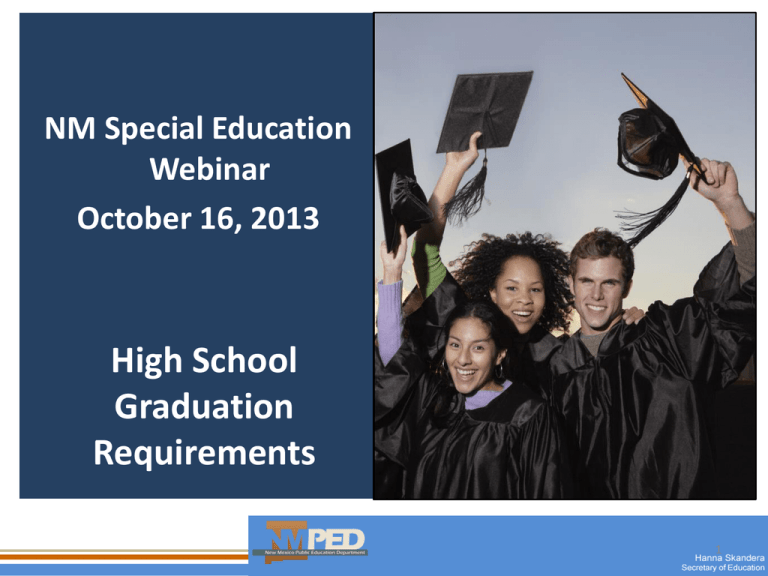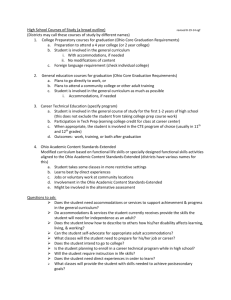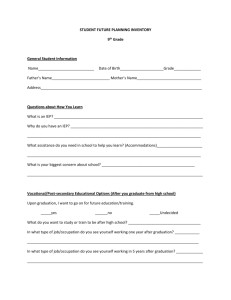Standard Pathway - New Mexico State Department of Education
advertisement

NM Special Education Webinar October 16, 2013 High School Graduation Requirements 1 Graduation Requirements 1. Standard Pathway • Accommodations 2. Alternate Pathways 3. Documentation 2 Standard Pathway Graduation Requirements 1. Course Requirements 2. Assessment Requirements 3 Standard Pathway Course Requirements • 4 credits ELA • 4 credits math including Algebra II or equivalent • 3.5 credits social studies including US History and Geography, World History and Geography, Government and Economics, and 0.5 credit of NM History • 3 credits science, 2 of which must be lab sciences • 1 credit physical education • 1 career cluster course, workplace readiness or non-English language • 7.5 elective credits • 1 course of health (starting with 2017 cohort) in HS or MS 4 Standard Pathway Course Requirements At least one course must be Honors (H), Advanced Placement (AP), Dual Credit (DC), or Distance Learning (DL). 5 Assessment Requirements Based on Statute NMSA 22-13-1-1 6 NMSA 22-13-1-1-M Beginning with the 2010-2011 school year, a student shall not receive a New Mexico diploma of excellence if the student has not demonstrated competence in the subject areas of mathematics, reading and language arts, writing, social studies and science, including a section on the constitution of the United States and the constitution of New Mexico, based on a standards-based assessment or assessments or a portfolio of standards-based indicators established by the department by rule. Assessment Requirements for HS Graduation Primary Demonstration of Competency • Math, Reading, Science: Pass SBA/HSGA • Writing and Social Studies: Pass 1 EoC in each subject Assessment Requirements for HS Graduation HSGA Proficient (Passing) Scores • Math: 1137 • Reading: 1137 • OR 2273 combined Math + Reading (with neither at “Beginning Step”) • Science: 1138 Assessment Requirements for HS Graduation EoC Proficient (Passing) Scores • Set by “Bookmark Method” of standard setting • Depend on the version • Published in the EoC Manual Alternate Demonstration of Competency (ADC) ADC: Provides additional opportunities for students to meet assessment requirements. ADCs include: EoCs CCR Indicators See Graduation Checklist for options and CCR cut scores. 11 Alternate Demonstration of Competency (ADC) • If students do not demonstrate competency initially, they may use cut scores for one of the following as an ADC: » ACT » PLAN » PSAT » SAT » Accuplacer » COMPASS » IB Program » AP » EoC EoCs for High School Graduation—ADCs MATH Algebra I* Algebra II Integrated Math III Math ADC SCIENCE Biology Chemistry READING ELA III Reading ELA IV Reading SOCIAL STUDIES Economics NM History U.S. Government U.S. History World History and Geog. WRITING ELA III Writing ELA IV Writing Student must pass Algebra II course to use Algebra I EoC. District-Developed EoCs • Districts may develop EoCs for any course for graduation purposes. • Follow FULL SET OF Quality Criteria and submit for approval. • http://www.ped.state.nm.us/AssessmentAccountability/Assessme ntEvaluation/EOC/2013/EoC%20Quality%20Criteria%20V.1.1FINA Lpdf.pdf Assessment Requirements A student must attempt ALL administrations of the SBA/HSGA (H2, H3, H4 retakes) before implementing a passing EoC or other ADC score for reading, math, or science. Students may bank passing scores proactively. 15 Testing Best Practices • ALL students may use “Best Practices” during assessments. • Use of Best Practices does not require an IEP. • Use should be determined and documented by the Student Assistance Team (SAT). 16 Testing Best Practices • Additional time between sessions • Face student during test administration • Group students by testing accommodation • Multiple and frequent breaks • Extended administration time 17 Testing Best Practices • Preferential seating • Schedule additional time between sessions • Test individually • Test in location with minimal distraction • Test in small group (fewer than 10) • Visual, verbal, or tactile reminders to stay on task • Place markers 18 Accommodations Coded accommodations allowed for students with IEPs, 504 Plans, or current ELL status. 19 Biogrid Codes Specific Accommodations for Testing. Biogrid codes for all accommodations (See Accommodations Manual) 20 Accommodations Braille Version Large Print Signing of Test Read Aloud Test Items Read Aloud to Self Assist Tech-Presentation Color Overlays Math Manipulatives Manipulating Materials Blank Graphic Organizer Scribe-Selected Response Scribe-Constructed Response Assist Tech-Response Audio Record Responses PED-Approved Accommodation 21 Accommodations • Students must have used accommodations in daily instruction prior to use on standardized assessments. • Train TAs and Proctors on administration of accommodations. • Maintain records of testing accommodations administered during testing. 22 Accommodations • Some classroom accommodations may NOT be used during testing. • Modifications are NOT ALLOWED. 23 Accommodations Accommodation: an adjustment that removes a barrier presented by a disability to grant a student equal access as students without the disability. Modification: change in the delivery, content, or complexity of an assessment that lowers expectations and/or assessed standards. 24 Non-Allowed Accommodations/Modification - Example The read-aloud accommodation does not include the reading portion. The reading portion of the SBA may NOT be read aloud. 25 Accommodations for ELLs Read Aloud in English Picture Dictionary Spanish Language Version Customized Dual Language Glossary Commercial Word-To-Word Dictionary Pocket Word-To-Word Translator Read-Aloud Test Directions in Spanish Read-Aloud Test Items in Spanish PED-Approved Accommodation 26 Spanish-Speaking ELLs All Assessments are available in Spanish • SBA/HSGA • EoCs 27 ELLs: First 3 Years in U.S. Schools Students may take assessments in Spanish or use Translator (for other languages). 28 th 4 & th 5 Years in U.S. Schools Students participate in English language version of assessments. Waiver allows students to continue assessing in native language for 2 additional years. Student must maintain ELL status to test in Spanish. 29 Questions about Standard Pathway graduation requirements? 30 Alternate Pathways 1) Standard 2) Career Readiness 3) Ability 31 Graduation Requirements by Pathway Pathway Standard Career Ability Course Requirements Assessment Requirements Meet required credit # through pre-determined courses (with some choice) Meet established passing scores on required tests (HSGA/EoCs) with or without accommodations. Meet required credit # through mix of standard and alternate courses determined by IEP team. Minimum 4 units of career development courses/experiences. Meet individualized passing scores on required tests (HSGA/EoCs) determined by IEP team. Determined by IEP team to reflect student abilities. Meet individualized passing scores on all subjects of the Alternate Assessment (NMAPA → NCSC) 32 Standards by Pathway Pathway Standard Career Ability Standards • ELA, Math: CCSS • Science, Social Studies: NMSS • ELA, Math: CCSS • Science, Social Studies: NMSS • NM Board of Education’s Career Readiness Standards with Benchmarks • ELA, Math: CCEGBE • Science, Social Studies: NMEGBE 33 NM Diploma of Excellence NM diploma is the same regardless of the pathway. 34 Career Pathway • Alternate program of study that develops students’ career interests and workplace readiness. • Goal: To produce students with the ability to gain meaningful employment. 35 Career Pathway Should a student be on the Career Pathway? 1) Document rationale (on IEP) for rejecting standard pathway. 2) Base decisions on needs of student (not credit number or test scores). 3) Give parent/guardian information and obtain agreement. 36 Career Readiness Standards with Benchmarks Listed in the CONTENT STANDARDS WITH BENCHMARKS AND PERFORMANCE STANDARDS FOR CAREER AND TECHNICAL EDUCATION, GRADES 7-12 in Subsection 2.29.3.8 NMAC http://www.nmcpr.state.nm.us/nmac/ 37 Career Readiness Standards with Benchmarks Standard I: Students will know and understand the importance of employability skills: BENCHMARK 1: Identify and demonstrate the use of positive work behaviors and personal qualities needed to be employable. BENCHMARK 2: Develop a personal career plan to meet career goals and objectives. BENCHMARK 3: Demonstrate skills related to seeking and applying for employment to find and obtain a desired job. 38 Career Readiness Standards with Benchmarks Standard II: Students will explore, plan and effectively manage careers: BENCHMARK 1: Maintain a career portfolio to document knowledge, skills and experience in a career field. BENCHMARK 2: Demonstrate skills in evaluating and comparing employment opportunities in order to accept employment positions that match career goals. BENCHMARK 3: Identify and exhibit traits for retaining employment to maintain employment once secured. BENCHMARK 4: Identify and explore career opportunities in one or more career options to build an understanding of the opportunities available in the cluster. 39 Career Readiness Standards with Benchmarks Standard II: Students will explore, plan and effectively manage careers: BENCHMARK 5: Recognize and act upon requirements for career advancement to plan for continuing education and training. BENCHMARK 6: Continue professional development to keep current on relevant trends and information within the industry. BENCHMARK 7: Examine licensing, certification and credentialing requirements at the national, state and local levels to maintain compliance with industry requirements. BENCHMARK 8: Examine employment opportunities in entrepreneurship to consider entrepreneurship as an option for career planning. 40 Ability Pathway • For students with severe cognitive impairments that affect the student in multiple settings (school, home, community). • Goal: To produce students with the ability to gain meaningful employment. 41 Extended Grade Band Expectations Based on CCSS and NMSS. Meaningful for Ability Pathway students. http://ped.state.nm.us/AssessmentAccountability/A ssessmentEvaluation/NMAPA/index.html 42 Questions about the Pathways? 43 Documentation for Graduation All Students: 1) Course credits completed 2) Assessment scores and pass/fail status 44 Documentation for Graduation Standard Pathway: • Next Step Plan • 8th – 12th Grades • Includes: • Plan for coursework based on post-graduation plans. • 12th grade Final Next Step Plan includes plans for college, trade program, internship, military service, or employment. 45 Documentation for Graduation Standard Pathway: • IEP can replace Next Step Plan for SWD. • Same requirements: • Plan for coursework based on post-graduation plans. • 12th grade IEP includes plans for college, trade program, internship, military service, or employment. 46 Important Graduation Information in IEP FOR ALL STUDENTS WITH IEPs: • Documentation of Exceptionalities • Annual IEP Meeting Documents • Classroom Accommodations • Assessment Accommodations (and Best Practices) • Coursework and Post-Secondary Plans 47 Important Graduation Information in IEP ADDITIONAL DOCUMENTATION FOR STUDENTS ON THE CAREER READINESS PATHWAY: • Rationale for placement on Career Pathway • Program of study with career cluster • Plan to achieve competency (and documentation of success) in all Career Readiness Standards and Benchmarks • Results of assessments and IEP-team established individualized passing scores 48 Guidelines for Setting Passing Scores on Graduation Assessments for CAREER and ABILITY PATHWAY STUDENTS 1. Review student success in instruction and on assessments Progress in classroom Results from interim assessments Scores on first attempt of the Graduation Assessment 49 Guidelines for Setting Passing Scores on Graduation Assessments for CAREER and ABILITY PATHWAY STUDENTS 2. Identify the subject area(s) in which the student performed below the established cut score. The student is reported to the state as “not proficient” in this area. 50 Guidelines for Setting Passing Scores on Graduation Assessments for CAREER and ABILITY PATHWAY STUDENTS 3. Using information about the student’s ability, potential, and progress, determine an attainable target score for each subject on the assessment. The target scores must be higher than the scores achieved on the first attempt, to promote progress. 51 Guidelines for Setting Passing Scores on Graduation Assessments for CAREER and ABILITY PATHWAY STUDENTS The IEP Team may establish new passing scores after each assessment attempt, if necessary. 52 Questions about Documentation? 53 Contact Information Joslyn Overby Education Administrator Assessment and Evaluation Joslyn.Overby@state.nm.us 505-827-6570 54







